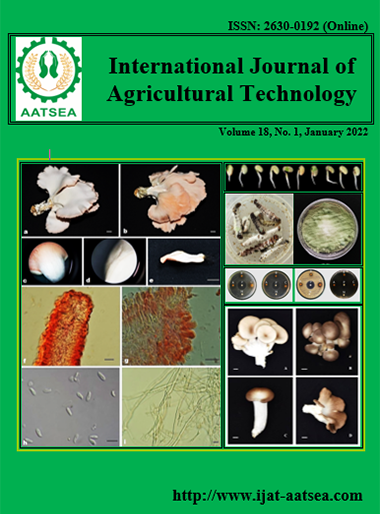The influence of fattening periods on chemical composition, fatty acid profile, cholesterol and ribonucleotide content of Charolaise crossbred steers
Main Article Content
Abstract
The chemical composition, fatty acid profile, cholesterol, and ribonucleotide content of longissimus thoracis muscle from Charolaise crossbred steers fattened for 12 and 15 months were investigated. Chemical composition did not differ between the two fattening periods. Fat content was 4.38 and 4.66 %, moisture content 72.79 and 71.14 %, ash content 1.24 and 1.23 %, and protein content 23.60 and 23.73 % for fattening periods of 12 and 15 months, respectively. Fatty acid composition was not affected by fattening period, except that C15:0 content was higher in steers fattened for 12 months than in steers fattened for 15 months (P < 0.05). There was no effect of fattening period on cholesterol content (P > 0.05). As for the effect of fattening period on ribonucleotide content, only guanosine monophosphate (GMP) of steers fattened for 12 months was significantly higher than those of steers fattened for 15 months (P < 0.05)
Article Details

This work is licensed under a Creative Commons Attribution-NonCommercial-NoDerivatives 4.0 International License.
References
AOAC (2005). Officials Methods of Analysis. 18th ed. Association of official analytical chemist International, Maryland, USA.
Bunmee, T., Chaiwang, N., Kaewkot, C. and Jaturasitha, S. (2018). Current situation and future prospects for beef production in Thailand. Asian-Australasian Journal of Animal Sciences, 7:968-975.
Bureau of Biotechnology in Livestock Production (2018). Charolais purebred. Retrieved from http;//biotech.dld.go.th/webnew/index.php/th/.
Bureš, D., Bartoň, L., Zahrádková, R., Teslík, V. and Krejčová M. (2006). Chemical composition, sensory characteristics, and fatty acid profile of muscle from Aberdeen Angus, Charolais, Simmental, and Hereford bulls. Czech Journal of Animal Science, 51: 279-284.
Chaiwang, N., Jaturasitha, S., Sringam, K., Wicke, M. and Kreuzer, M. (2015). Comparison of the meat quality of Thai indigenous Upland Cattle and F2-crossbreds with 75% Charolais blood proportion. Journal of Applied Animal Research, 43:196-201.
Du, M. and Ahn, D. U. (2002). Simultaneous analysis of tocopherols, cholesterol, and phytosterols using gas chromatography. Journal of Food Science, 67:1696-1700.
Folch, J., Lees, M. and Stanley, G. H. S. (1957). A simple method for the isolation and purification of total lipides from animal tissues. Journal of Biological Chemistry, 226:497-509.
Jones, N. R. (1969). Meat and fish flavors; significance of ribomononucleotides and their metabolites. Journal of Agricultural and Food Chemistry, 17:712-716.
Kang, M. J., Lee, E. K. and Lee, S. S. (2004). Effects of two P/S ratios with the same peroxidizability index value and antioxidants supplementation on serum lipid concentration and hepatic enzyme activities of rats. Clinica Chimica Acta, 350:79-87.
Kang, M. J., Shin, M. S., Park, J. N. and Lee, S. S. (2005). The effects of polyunsaturated: saturated fatty acids ratios and peroxidisability index values of dietary fats on serum lipid profiles and hepatic enzyme activities in rats. British Journal of Nutrition, 94:526-532.
Kheawrod, W., Sivapirunthep, P., Thiwaratkoon, P., Chongcharoen, M., Chancharoen, P., Yathongchai, W. and Chaosap, C. (2020). The influence of fattening periods on performance, carcass composition, and meat quality of Charolaise crossbred steers. International Journal of Agricultural Technology, 16:1397-1406.
Macleod, G. (1998). The Flavour of Beef. In Flavor of meat, meat products and seafoods. In: Shahidi F ed. Blackie Academic and Professional, London, UK. pp.27-60.
Maher, S. C., Mullen, A. M., Moloney, A. P., Drennan, M. J., Buckley, D. J. and Kerry, J. P. (2004). Colour, composition and eating quality of beef from the progeny of two Charolais Sires. Meat Science, 63:491-500.
Muroya, S., Oe, M., Ojima, K. and Watanabe, A. (2019). Metabolomic approach to key meta-bolites characterizing postmortem aged loin muscle of Japanese Black (Wagyu) cattle. Asian-Australasian Journal of Animal Science, 32:1172-1185, doi:10.5713/ajas.18. 0648.
Nogalski, Z., Pogorzelska, P. P., Sobczuk, S. M., Nogalska, A., Modzelewska, K. M. and Purwin, C. (2018). Carcass characteristics and meat quality of bulls and steers slaughtered at two different ages. Italian Journal of Animal Science, 17:279-288.
Office of agricultural economics (2020). Agricultural Economic Research. Retrieved from https://www.oae.go.th/assets/portals/1/ ebookcategory/57_trend-2564/#page=1.
Raes, K., Smet, S. and Demeyer, D. (2001). Effect of double-muscling in Belgian Blue young bulls on the intramuscular fatty acid composition with emphasis on conjugated linoleic acid and polyunsaturated fatty acids. Animal Science, 73:253-260.
Tikk, M., Tikk, K., Tørngren, M., Meinert, L., Aaslyng, M., Karlsson, A. and Andersen, H. (2006). Development of Inosine Monophosphate and Its Degradation Products during Aging of Pork of Different Qualities in Relation to Basic Taste and Retronasal Flavor Perception of the Meat. Journal of Agricultural and Food Chemistry, 54:7769-7777, doi:10.1021/jf060145a.
Venn-Watson, S., Lumpkin, R. and Dennis, E. A. (2020). Efficacy of dietary odd-chain saturated fatty acid pentadecanoic acid parallels broad associated health benefits in humans: could it be essential. Scientific Reports, 10:8161. doi:10.1038/s41598-020-64960-y.
Waritthitham, A., Lambertz, C., Langholz, H. J., Wicke, M. and Gauly, M. (2010). Assessment of beef production from Brahman Thai native and Charolais Thai native crossbred bulls slaughtered at different weights II: Meat quality. Meat Science, 85:196-200.


